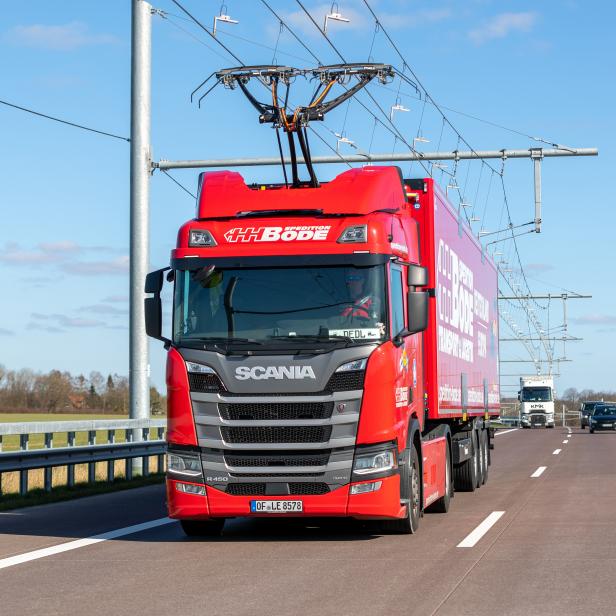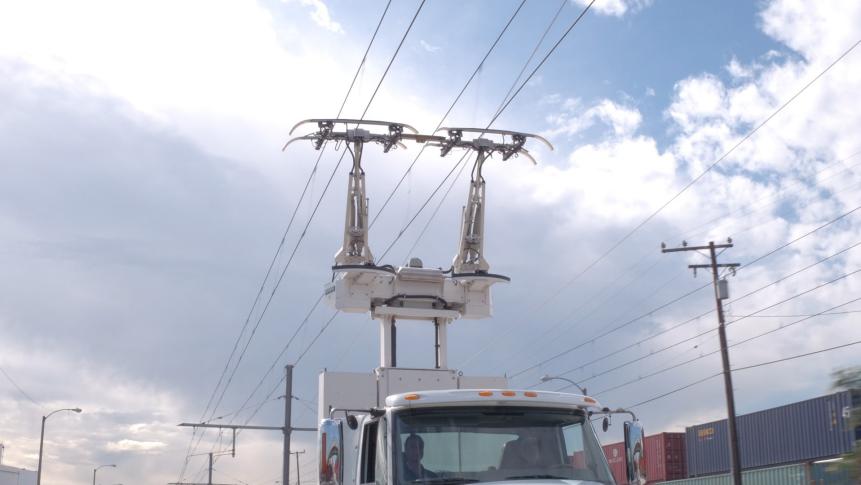
Ulrich Wirrwa
Are Electric Highways the Way of the Future?
There’s a longstanding debate on how to reduce emissions in the trucking industry. Germany is testing out a new system — eHighways, which feed electricity to trucks while they drive.
Figuring out how to reduce emissions in the commercial trucking industry is key to the fight against climate change. Because long-haul diesel trucks spend so much time on the road, they disproportionately produce pollutants, greenhouse gases, and contribute to dirty air.
Germany is at the forefront of this fight against truck emissions.
Using wires strung above the highway and a pantograph (current collector) mounted to the top of a truck, Germany’s eHighways use technology similar to that of an electric city bus. The system delivers power directly from the electrical line straight to the truck’s motor.

Close-up of a truck's pantograph during an eHighway test in Carson, CA in 2017.
Adapting the same equipment that is used for driving trains and urban street cars, Siemens, the German electricity company, provided the equipment for the test route — stringing miles of high-voltage electrical cable above the Autobahn.
The eHighway system saves truckers weight and money compared to outfitting trucks with electric batteries — which could be both heavy and expensive. Using overhead wires on the freeway, a truck would only need a big enough battery to drive the short distance from the offramp to its destination. Not to mention, the money trucking companies would save on fuel, their largest cost.

Michael Poganiatz
Siemens just inked a deal with Continental to mass-produce pantographs to supply trucks across Europe.
While this system saves money in the long term, stringing thousands of miles of electrical cable above freeways would be costly to German taxpayers. Is it feasible? For now, Germany is just testing it out. The eHighway system has also been tested in Sweden and a 1-mile stretch near Long Beach, California.
It would take 2,500 miles of electrical wiring to accommodate about 60% of German truck traffic. So far, only a couple 3-mile-stretches of highway outside Frankfurt, Schleswig-Holstein, and Baden-Württemberg are equipped with overhead electrical cables. By the end of the year, more than 20 trucks carrying real loads will be using the system. The companies funding the project want to see how the eHighway stretch performs in everyday use.
Building the overhead cables would cost the German government about $5 million dollars per mile. Germany’s Ministry of Environment will compare the results of this project with studies of trucks using electric batteries and hydrogen fuel cells. Based on the data, the ministry plans to decide in three to four years which eco-friendly technology to invest in and support.
“Numerous studies have come to the conclusion that overhead cable trucks, despite the high infrastructure costs, are the most cost-effective option,” the Ministry of Environment said to The New York Times.
No matter which option the ministry chooses, the goal is to create a more environment-friendly future for the commercial trucking industry.









